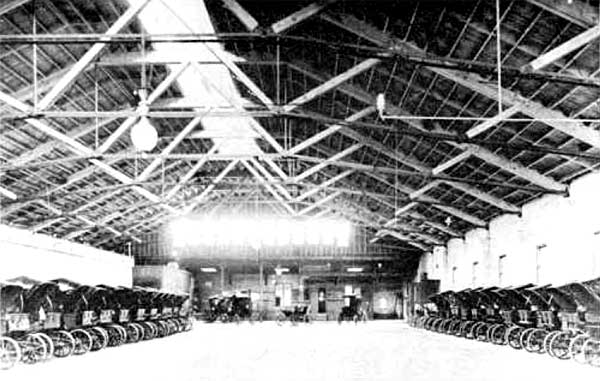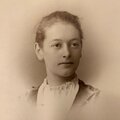Buffalo's Electric Automobiles c. 1905
A group of mostly female motorists gathered
before the fountain at the Albright Art Gallery c. 1909. The photo appeared in
the catalog of the Babcock Automobile Company of Buffalo.
They were sitting in a style called the "stanhope" (also manufactured by other companies) which featured a single bench seat, folding cloth top, front buckboard, and tiller steering. A 1904 Buffalo stanhope cost $1640 ($33, 864 in 2005 dollars). At this stage in automobile manufacturing, all vehicles were purchased by the wealthy.
A typical wealthy Buffalo couple might have two automobiles: an electric for the women in the family and a gasoline auto for the men in the family. The electric automobile was quiet, easy to operate, and emission-free; it was also heavy, slow, unable to climb hills, and in need of recharging after 20-50 miles.
Such a vehicle was quickly marketed to women, doctors, delivery businesses and others residing in an urban environment where electricity for recharging was available. The gasoline automobile had already been adopted by men for its speed and "portability," i.e. it could "tour" in rural areas and be re-fueled at gasoline stations that quickly sprang up around Western New York. The Buffalo Automobile Club was a touring club for gasoline vehicles; its membership was male.
The Buffalo Electric Carriage Company garage at 240 W. Utica Street, lined with new Stanhopes c. 1905.
Although in 1900, equal numbers of electric-, gasoline- and steam-powered automobiles were produced in the U.S., it quickly became apparent that electrics would not succeed in competition with gasoline models (becoming more reliable each year) unless a revolution in the electric battery came about that would result in a lighter battery that would produce more power for a longer run per charge. Thomas Edison took on this challenge (see his optimism here) and did produce an early alkaline battery, but it was not powerful enough to replace the lead-acid battery then used in electrics.
In 1908, there were 300 electric automobiles privately owned in Buffalo; more were used daily by delivery companies. But Henry Ford had begun mass-production of gasoline vehicles in 1904, driving down the price of owning an automobile. And in 1913, a battery-powered electric starter eliminated the dangerous manual crank-starting of automobiles, opening the way for widespread ownership by women.
The Buffalo Electric Carriage Company (1900 - 1906), which became the Babcock Electric Carriage Company (1906 - 1912), changed its ownership again in 1912. It became The Buffalo Electric Vehicle Company and had a short life. It continued manufacturing at the 1911 complex at 1219-1247 Main Street in Buffalo (at Northhampton St.) but by 1916, it was out of business, one of 30 automakers that came and went in Buffalo in the twentieth century.
N.B. The Buffalo Electric Vehicle Company building still stood in 2006 and was being transformed by Art Space into artists' residential and work space.
Excerpt from "Why She Wanted An Automobile"
Jennette Lee, Lippincott's Magazine
Reprinted Buffalo Evening News, December 22, 1902
."..I've always wanted, ever since I was born, to ride somethin' that went by itself. I've pulled horses up and down these hills till I'm sick to death of it. I've al'ays set far forred on the seat an' breathed light so's not to weigh so much, an' I want to ride in somethin' I can lean back in an' weigh heavy 'fore I die - somethin' that I won't have to think all the time how tired it's gettin.'"













